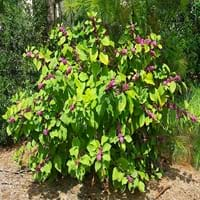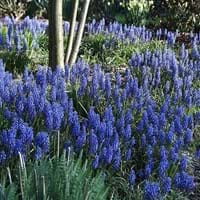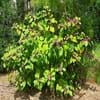Life Span
Perennial
Perennial
Type
Shrub
Bulb or Corm or Tuber
Origin
Southeastern United States, South-Central United States
Mediterranean, Southeastern Asia
Types
Not Available
Not available
Habitat
bottomlands, Coastal Regions, Moist woods, pine woods, Slopes, Swamps, Thickets, Woods
Fields, Open areas, Terrestrial
USDA Hardiness Zone
6-11
Not Available
AHS Heat Zone
12-1
Not Available
Sunset Zone
3a, 3b, 4, 5, 6, 7, 8, 9, 14, 15, 16, 17, 18, 19, 20, 21, 22, 23, 24
21,22
Habit
Arching/Fountain-shaped
Clump-Forming
Minimum Height
Not Available
Minimum Width
Not Available
Flower Color
Pink, Lavender
White, Yellow, Blue, Purple, Pink, Olive, Blue Violet
Flower Color Modifier
Not Available
Bicolor
Fruit Color
Purple, White
Brown, Black
Leaf Color in Spring
Light Green
Not Available
Leaf Color in Summer
Light Green
Light Green
Leaf Color in Fall
Yellow green, Tan
Several shades of Green
Leaf Color in Winter
Not Available
Light Green
Leaf Shape
Elliptic
Narrow
Plant Season
Spring, Summer, Fall
Not Available
Sunlight
Full Sun, Partial Sun, Partial shade
Full Sun, Partial Sun
Growth Rate
Medium
Not Available
Type of Soil
Clay, Loam, Sand
Not Available
The pH of Soil
Acidic, Neutral
Not Available
Soil Drainage
Well drained
Well drained
Bloom Time
Early Summer, Summer, Late Summer
Not Available
Tolerances
Not Available
Drought
Where to Plant?
Ground, Pot
Container, Ground, Pot
How to Plant?
Cuttings, Seedlings
From bulbs, From Rhizomes, Seedlings
Plant Maintenance
Medium
Medium
Watering Requirements
Medium
Get enough water whenever the soil is dry, Keep the ground moist but not water-logged, Keep the Soil well drained
In Summer
Lots of watering
Lots of watering
In Spring
Moderate
Moderate
In Winter
Average Water
Average Water
Soil pH
Acidic, Neutral
Not Available
Soil Type
Clay, Loam, Sand
Not Available
Soil Drainage Capacity
Well drained
Well drained
Sun Exposure
Full Sun, Partial Sun, Partial shade
Full Sun, Partial Sun
Pruning
No need to prune
Remove damaged leaves, Remove dead branches, Remove dead leaves
Fertilizers
All-Purpose Liquid Fertilizer, fertilize in spring, Use a fertilizer ratio of 16-4-8
All-Purpose Liquid Fertilizer
Pests and Diseases
Red blotch
Armored scales, Crown rot, Slugs
Plant Tolerance
Not Available
Drought
Flower Petal Number
Single
Single
Foliage Texture
Coarse
Medium
Foliage Sheen
Matte
Glossy
Attracts
Birds, Butterflies
Bees, Butterflies
Allergy
Poisonous
Diarrhea, Itchiness, Skin irritation, Stomach pain, Vomiting
Aesthetic Uses
Showy Purposes
Cottage Garden, Landscape Designing
Beauty Benefits
Not Available
Not Available
Environmental Uses
Air purification, Food for animals, Food for birds
Air purification
Medicinal Uses
Colic, Dysentry, Fever, Malaria, Rheumatism, Stomach pain
Diuretic, Stimulates new cell growth
Part of Plant Used
Flowers, Root
Buds, Flowers
Other Uses
Showy Purposes, Used as Ornamental plant, Used for bedding in gardens, Used for fragrance, Used for its medicinal properties, Used for Landscaping
Traditional medicine, Used for fragrance
Used As Indoor Plant
No
Yes
Used As Outdoor Plant
Yes
Yes
Garden Design
Foundation, Mixed Border, Screening, Wind Break
Container, Cutflower, Mixed Border, Rock Garden / Wall
Botanical Name
CALLICARPA americana
MUSCARI
Common Name
American beautyberry , French mulberry
Grape Hyacinth
In Hindi
American Beautyberry Tree
अंगूर जलकुंभी
In German
Amerikanische Schönbaum
Traubenhyazinthen
In French
Américaine Beautyberry Arbre
Muscari
In Spanish
Americana beautyberry Árbol
Muscari
In Greek
American Beautyberry Δέντρο
grape hyacinth
In Portuguese
Árvore Beautyberry Americana
Muscari
In Polish
Amerykański pięknotka Drzewo
Szafirek
In Latin
Latin Beautyberry ligno
Muscari
Phylum
Magnoliophyta
Tracheophyta
Class
Magnoliopsida
Magnoliopsida
Order
Lamiales
Asparagales
Family
Verbenaceae
Asparagaceae
Clade
Angiosperms, Asterids, Eudicots
Angiosperms, Monocots
Tribe
Not Available
Not Available
Subfamily
Ranunculoideae
Scilloideae
Number of Species
Not Available
Season and Care of American Beautyberry and Grape Hyacinth
Season and care of American Beautyberry and Grape Hyacinth is important to know. While considering everything about American Beautyberry and Grape Hyacinth Care, growing season is an essential factor. American Beautyberry season is Spring, Summer and Fall and Grape Hyacinth season is Spring, Summer and Fall. The type of soil for American Beautyberry is Clay, Loam, Sand and for Grape Hyacinth is Not Available while the PH of soil for American Beautyberry is Acidic, Neutral and for Grape Hyacinth is Not Available.
American Beautyberry and Grape Hyacinth Physical Information
American Beautyberry and Grape Hyacinth physical information is very important for comparison. American Beautyberry height is 182.88 cm and width 182.88 cm whereas Grape Hyacinth height is Not Available and width Not Available. The color specification of American Beautyberry and Grape Hyacinth are as follows:
American Beautyberry flower color: Pink and Lavender
American Beautyberry leaf color: Light Green
Grape Hyacinth flower color: White, Yellow, Blue, Purple, Pink, Olive and Blue Violet
- Grape Hyacinth leaf color: Not Available
Care of American Beautyberry and Grape Hyacinth
Care of American Beautyberry and Grape Hyacinth include pruning, fertilizers, watering etc. American Beautyberry pruning is done No need to prune and Grape Hyacinth pruning is done Remove damaged leaves, Remove dead branches and Remove dead leaves. In summer American Beautyberry needs Lots of watering and in winter, it needs Average Water. Whereas, in summer Grape Hyacinth needs Lots of watering and in winter, it needs Average Water.





